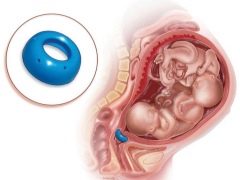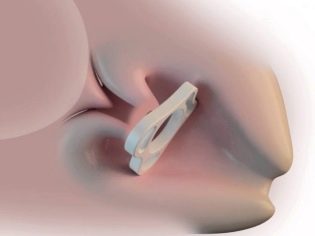Features of childbirth after removal of the pessary
Obstetric pessary helps women with a weak cervix to bring the pregnancy to the end, saves the life of the child. But shortly before the term of birth, such pregnant women have many questions, the main ones of which concern whether the contractions with the pessary can begin and how long after the removal of the device labor can begin.
In this article we will try to give answers to all these questions.
How and when to install?
The need to install a pessary, which is a tight ring, on the cervix usually occurs in the second trimester of pregnancy in women with identified pathologies of the state of the cervix. The function of the ring in this case is to keep the uterus in the closed state, thereby preventing miscarriage, premature birth.
As a result, the pressure of the fetus on the cervix from the inside is compensated and distributed more evenly.
More often pessary put after 20 weeks of pregnancy and up to 32–33 weeks. The procedure is quick, practically painless. But the very installation of a rubber or latex ring can provoke childbirth or miscarriage, and therefore doctors always weigh the existing and potential risks.
The pessary installed with its edges reliably rests against the vaults of the vagina, which provides it with a reliable and stable position.
The pessary is not able to make a pathologically short cervix when carrying a fetus longer - it only allows in most cases to prolong the pregnancy with high efficiency.
After the expectant mother is placed a ring on the cervix (the procedure takes place in stationary conditions), special care and adherence to medical recommendations are required of her.
Excessive physical exertion, sexual acts, stress and excitement are prohibited. Once a week it is recommended to do a smear analysis on the state of the vaginal microflora.: this will help eliminate infection. Vaginal suppositories are often prescribed.
In the case of severe isthmic-cervical insufficiency, after bedding of the fixing ring on the neck, the woman is shown bed rest until childbirth.
How to shoot?
Do not think that removing the pessary is a more complicated task than installation. Usually, removing a latex or rubber ring from the cervix is even easier and faster than installing. After removal, you must carefully follow the rules of intimate hygiene, irrigation of the genital tract prescribed by the doctor solution.
Pessary usually removed at 38 week. It should be noted that the preparation of the pregnant woman's body for childbirth itself does not at all depend on whether or not there is a fixation device on her cervix. Everything goes on as usual, and therefore the 38th week is considered the best time to remove the ring. The child is mature enough to easily adapt to its new environment after birth. The birth canal to this date is also almost always ready, the hormonal background is “tuned” to the generic activity.
Commencement of labor
One of the most common questions is whether labor can begin before the ring is removed. They can, because, as we found out, the internal preparation for this reflex act in no way depends on whether there is a foreign body on the cervix or it does not exist.
Births after the 37th week of pregnancy with an established pessary should not be taken as a tragedy.. The baby is full-term, and the birth process itself will differ little from the classical ones, except that the cervical dilatation will proceed somewhat faster, which in a certain way will shorten the total time of delivery.
If childbirth begins with an established ring-lock before 37 weeks, you also need to remain calm - the modern level of resuscitation care allows you to care for even very premature babies.
At the beginning of labor can indicate regular contractions, which begin to repeat with a certain frequency. Also, the beginning may be marked by the discharge of amniotic fluid.
If a pregnant woman without a pessary can afford to be at home until the contractions have gained a certain strength and intensity, then An expectant mother with a ring on the uterus should call an ambulance right away. So that the cervix does not suffer, the pessary should be removed as soon as possible..
There are cases when during the fights the pessary slides itself, but it is better to be safe. In the hospital, an obstetrician will necessarily remove the pessary, and the subsequent course of labor will be normal. It is not necessary to assume that childbirth will necessarily be swift or rapid when the pessary leaves its place and stops fixing the cervix. There was no pattern between wearing the pessary and the rapid delivery, the risk of the probability of such anomalous labor is on basic values, as in women who did not wear rings on the uterus.
Where more dangerous is the onset of spontaneous labor when surgical sutures are placed on the neck. During contractions, they can "cut through" the cervix, leading to serious injury.
Despite the greater safety of the pessary, women with stitches and women with a rubber or latex ring on the neck are advised to go to the maternity hospital beforehand. Most often - at 38–39 weeks of gestation.
If there are no accompanying pathologies, after removing the pessary at 38 weeks they can let go home — wait for the onset of labor. If there are other complications of pregnancy, it is likely that the woman will be left in the hospital under the supervision of doctors.
When will childbirth begin?
It is very interesting for women who have their pessary taken on time, on time, before the onset of labor, to know when to expect the onset of labor. The baby can begin to be born at any time.
Sometimes it takes about half an hour after removing the latex ring before the start of the first contractions, and sometimes you have to wait. On average, statistics show that most parturient women give birth 7–9 days after the fixture removes.
After the ring is removed, the pressure of the fetal head on the inner opening of the cervix is no longer compensated and distributed, it becomes quite strong. Under the influence of the changed hormonal background, as well as under the weight of the fetus, the internal pharynx begins to open and becomes funnel-shaped.
Behind him begins to open and external pharynx. This process is gradual, smooth, so the first signs of approaching the cherished day can be changes in the feelings of the future mother: there are aching, breaking pain in the lower back, the mucus plug departs, which can no longer be in the cervical canal due to its expansion when the inner throat opens.
Labor contractions will lead to a phased disclosure and pharynx external. The neck should open fully to 10–12 centimeters.to release the baby from the uterus to the birth canal.
Do not think that the mere presence of a pessary during pregnancy can somehow affect the upcoming birth processes. If the fixing device does not cause infection, then the birth will be the most common, no different from others.
There are also cases when the pregnancy was preserved by fixing the cervix with an obstetric pessary, and after withdrawal its independent labor activity did not develop until 41–42 weeks, and therefore there was a need to stimulate childbirth.
Reviews
According to women, when removing the pessary you need to be fully prepared (to collect the bag in the maternity hospital, to prepare the necessary documents and things), because childbirth can begin almost immediately after removing the ring. Waiting after removal can be quite painful, especially if you have to wait for a long time.
Many people worry that childbirth does not begin, although after removing the fixation device, the doctor stated cervical dilatation on 1–2 fingers. For this you can not worry. The absence of a mucous plug and a slightly opened neck is not a reason to believe that the life and health of a child is endangered. As long as the bladder is intact, the baby has reliable protection against viruses and bacteria, but reasonable precautions are still needed.: while waiting for childbirth after removing the pessary, it is important to follow the rules of intimate hygiene, wash several times a day, do not have sex, do not douching.
Many women, in whom repeated deliveries took place after wearing the pessary, claim that the generic process itself was simpler and easier than the first. Some primiparids also indicate that they managed to give birth quickly and fairly easily, because the cervix was opening faster.
More on the functions of obstetric pessary - in the next video.




























